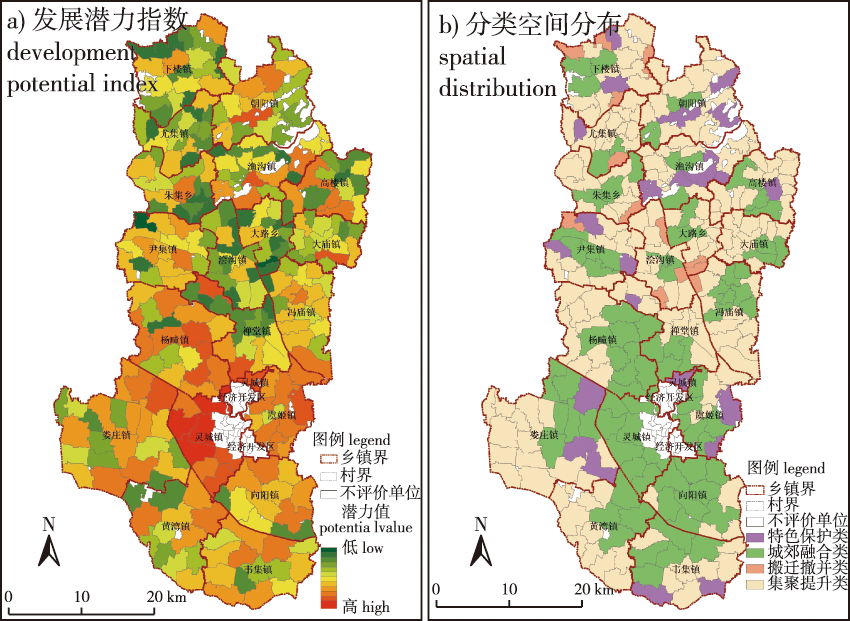 PDF(4132 KB)
PDF(4132 KB)


 PDF(4132 KB)
PDF(4132 KB)
 PDF(4132 KB)
PDF(4132 KB)
基于村庄发展潜力评价的景观格局研究
Landscape pattern study based on evaluating the development potential of villages
【目的】 在全面展开国土空间规划工作和实施乡村振兴战略的背景下,村庄发展潜力评价是乡村规划建设的基础性工作,也是国土空间规划中村庄规划的核心环节,用以指导村庄分类。【方法】 以“背景阐述—潜力评价—村庄分类—分类格局—发展策略”为研究路径,按照目标层-准则层-指标层的结构框架来构建7个准则层和19个指标层,通过层次分析法和熵权法确定指标的权重,并以安徽省灵璧县为例进行村庄分类,再基于Fragstats对分类村庄的景观格局进行分析。【结果】 安徽省灵璧县村庄分为集聚提升、城郊融合、特色保护、搬迁撤并共4类,且集聚提升类村庄景观面积最大、景观形状最复杂、景观集聚度最高;城郊融合类村庄斑块结合度最高,景观连通性最好;搬迁撤并类村庄景观复杂程度最高。【结论】 针对不同的村庄类型提出相应的发展策略:集聚提升类村庄已具备一定规模,是实现农村现代化的重要突破口,在进行建设时要优化村庄布局,适当调整村庄内部的结构,加大村庄基础设施以及村容村貌建设力度。对特色保护类村庄要充分考虑到保护与开发的关系,注重村庄特色完整性、真实性和延续性。对城郊融合类村庄进行建设时应当利用其区位优势,重点在改善村庄内部设施和优化空间布局等方面,不鼓励持续性的扩展,同时村庄的整体风貌也应区别于城市景观;产业发展结合村庄自身特点,积极整合村庄优势资源,强化城乡产业的对接融合。根据产业的不同进行区块划分,依次实现产业的集中发展和土地的集约经营;对于村庄内部的自然资源应当保护为主,合理利用,结合当地的资源打造特色旅游项目,从而发展村庄的旅游业。对搬迁撤并类村庄应通过空间整合与邻近区域发展潜力较高的村庄进行合并,形成村庄合并的规模效应,提升自身发展潜力和综合竞争力,同时考虑村民的搬迁意愿及乡村生态的修复。该研究可为县域乡村潜力评价及分类提供方法参考和决策依据。
【Objective】 As per the new era and the comprehensive development of territorial spatial planning and the proposed rural revitalization strategy, the evaluation of village development potential is basic to rural planning and construction. The evaluation is also the core link to village planning under territorial spatial planning and a key guide to the classification of villages. 【Method】 Taking “background explanation-potential evaluation-village classification-classification pattern-development strategy” as the research path, seven criterion layers and 19 indicator layers were constructed according to the structural framework of target layer-criterion layer-indicator layer. The weights of indicators were determined by AHP and the entropy weight method. Based on this, villages in Lingbi County in Anhui Province were classified. Next, the landscape pattern of classified villages was analyzed based on Fragstats. 【Result】 Lingbi County in Anhui Province was divided into four types of villages: agglomeration enhancement, suburban integration, characteristic protection and relocation and withdrawal. Agglomeration enhancement villages had the largest landscape area, the most complex landscape shape, and the highest landscape agglomeration degree. The patch integration degree of suburban-integrated villages was the highest with the best landscape connectivity. The landscape complexity of the villages of relocation and withdrawal was the highest. Corresponding development strategies were proposed for different village types. 【Conclusion】 Corresponding development strategies are put forward for different village types: agglomeration and upgrading villages have a certain scale, an important breakthrough for rural modernization. During construction, the village layout should be optimized, the internal structure of the village should be properly adjusted, the construction of the village infrastructure should be improved, and the village’s appearance should be improved. The relationship between protection and development should be fully considered, and the integrity, authenticity, and continuity of village characteristics should be emphasized. In the construction of suburban-integrated villages, we should make use of their location advantages, focus on improving the village’s internal facilities, optimize the spatial layout, and discourage continuous expansion. At the same time, the overall style of the village should be different from the urban landscape—industrial development should be combined with the characteristics of the villages, village resources should be integrated, and the docking and integration of urban and rural industries should be strengthened. As per different industries, block division is conducted to realize the centralized development of industry and the intensive development of land. The natural resources in the villages should be protected, and rational land use and local resources should be combined to build characteristic tourism projects to develop village tourism. The relocation and withdrawal villages should merge, through spatial integration, with neighboring villages with high development potential to form the scale effect of village merger. The merger will enhance development potential and comprehensive competitiveness. The intention to relocate villagers and the restoration of rural ecology should be important considerations. The study provides method reference and a decision basis for the evaluation and classification of county-level rural potential.

乡村振兴战略 / 国土空间规划 / 村庄发展潜力评价 / 景观格局 / 安徽灵璧县
rural revitalization strategy / territorial spatial planning / evaluation of the development potential of villages / landscape pattern / Lingbi County, Anhui Province
| [1] |
沈婕, 王瑾, 马远航. 西北山区县域乡村空间发展引导的探索和实践:以岷县县域村庄布局规划为例[J]. 建筑与文化, 2016(5):37-40.
|
| [2] |
何杰, 金晓斌, 梁鑫源, 等. 城乡融合背景下淮海经济区乡村发展潜力:以苏北地区为例[J]. 自然资源学报, 2020, 35(8):1940-1957.
|
| [3] |
李卫锋, 王仰麟, 彭建, 等. 深圳市景观格局演变及其驱动因素分析[J]. 应用生态学报, 2004, 15(8):1403-1410.
|
| [4] |
柳迪子, 杜守帅, 王晨旭. 旅游型乡村景观格局变化及生态系统服务价值响应:以江苏省无锡市太湖国家旅游度假区为例[J]. 水土保持通报, 2021, 41(5):264-275,286.
|
| [5] |
|
| [6] |
|
| [7] |
|
| [8] |
|
| [9] |
|
| [10] |
|
| [11] |
|
| [12] |
|
| [13] |
|
| [14] |
|
| [15] |
|
| [16] |
|
| [17] |
黎智辉, 张一凡, 袁娟. 圩区村庄布局规划新思考[J]. 规划师, 2013, 29(8):56-60.
|
| [18] |
张卓然, 唐晓岚. 环太湖地区历史村落的环境适应性及特征[J]. 南京林业大学学报(自然科学版), 2020, 44(5): 17-24.
|
| [19] |
彭震伟, 王云才, 高璟. 生态敏感地区的村庄发展策略与规划研究[J]. 城市规划学刊, 2013(3):7-14.
|
| [20] |
张俊杰, 蔡克光, 蔡云楠. 全域风景化视角下都市村庄空间布局探讨:以广州村庄规划为例[J]. 城市发展研究, 2016, 23(5):56-62.
|
| [21] |
王昱之, 赵大伟. 基于灰色关联度的镇域村庄布局影响因素分析:以甘肃省达板镇为例[J]. 西北师范大学学报(自然科学版), 2017, 53(2):123-128.
|
| [22] |
夏国锋, 邬家峰, 王啸, 等. 村庄类型与农民公共精神的差异性呈现:胜利村、南坝村和十里村的比较[J]. 西北农林科技大学学报(社会科学版), 2013, 13(3):121-125.
|
| [23] |
孟欢欢, 李同昇, 于正松, 等. 安徽省乡村发展类型及乡村性空间分异研究[J]. 经济地理, 2013, 33(4):144-148,185.
|
| [24] |
张伟峰, 张立. 基于神经网络方法的乡村类型研究:西宁的案例[J]. 城市建筑, 2020, 17(1):45-49,53.
|
| [25] |
李琳, 冯长春, 王利伟. 生态敏感区村庄布局规划方法:以潍坊峡山水源保护地为例[J]. 规划师, 2015, 31(4):117-122.
|
| [26] |
杨春德, 翟荣新, 朱晓伟, 等. 田柳镇三村村庄布局优化实践[J]. 中国土地科学, 2011, 25(12):55-58.
|
| [27] |
姚龙, 刘玉亭. 基于聚类分析的城郊地区乡村发展类型:以广州市从化区为例[J]. 热带地理, 2015, 35(3):427-436.
|
| [28] |
朱泽, 杨颢, 胡月明, 等. 基于多源数据的村庄发展潜力评价及村庄分类[J]. 农业资源与环境学报, 2021, 38(6):1142-1151.
|
| [29] |
江国逊, 陈旭东, 石亚飞. 空心化村庄废弃地整理潜力研究:以江苏省邳州市为例[J]. 中国农业资源与区划, 2013, 34(5):107-110.
|
| [30] |
欧维新, 邹怡, 刘敬杰, 等. 基于乡村振兴潜力和土地利用效率的村庄分类研究[J]. 上海城市规划, 2021, 6(6):15-21.
|
| [31] |
|
| [32] |
孟超, 王计平, 支晓蓉, 等. 乡镇尺度森林景观格局特征与影响因素定量分析[J]. 农业机械学报, 2019, 50(3):212-220.
|
| [33] |
王佐霖, 黄钰辉, 杨龙, 等. 深圳森林生态系统类型自然保护区近20年土地利用与景观格局变化[J]. 林业与环境科学, 2019, 35(2):1-6.
|
| [34] |
马骅, 王义飞, 宁宇, 等. 若尔盖县高原湿地景观格局动态分析研究[J]. 林业资源管理, 2019(1):109-115.
|
| [35] |
邬建国. 景观生态学:格局、过程、尺度与等级[M]. 2版. 北京: 高等教育出版社, 2007.
|
/
| 〈 |
|
〉 |